Last Updated on: February 5, 2025
With their bright and fiery caps, birds with red heads are beautiful. Their crown especially stands out when the rest of their body has other colors.
However…
With the long list of feathered friends sporting a red head, identifying each can be difficult. Aside from the color, you should also know more about their habitats and feeding behaviors, especially if you want to attract them to your yard.
Read on and find out some of the most popular bird species with a beautiful and vibrant head that is sure to captivate attention.
The Most Common Birds with Red Head
1. Red-Headed Woodpecker
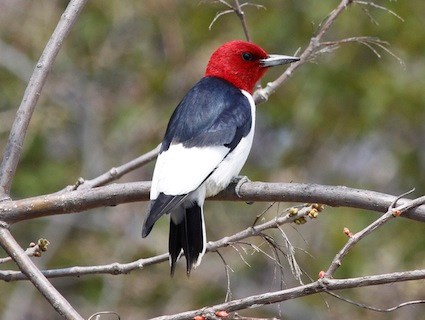
The name itself will already give you an idea of what this woodpecker looks like. This black and white bird has a completely red head, which you can easily spot even from afar.
You will find a red-headed woodpecker in Central Eastern United States and Southern Canada. They live in dying forests and areas near rivers or swamps.
Red-headed woodpeckers are known for storing food for later consumption. They hide them in tree bark or wood.
The majority of the diet of red-headed woodpeckers includes insects, earthworms, spiders, small rodents, and wild fruits. These birds are omnivores.
They are also known for being opportunistic and have varying foraging habits. They can also eat nestlings and eggs of other birds.
2. Red-Bellied Woodpecker
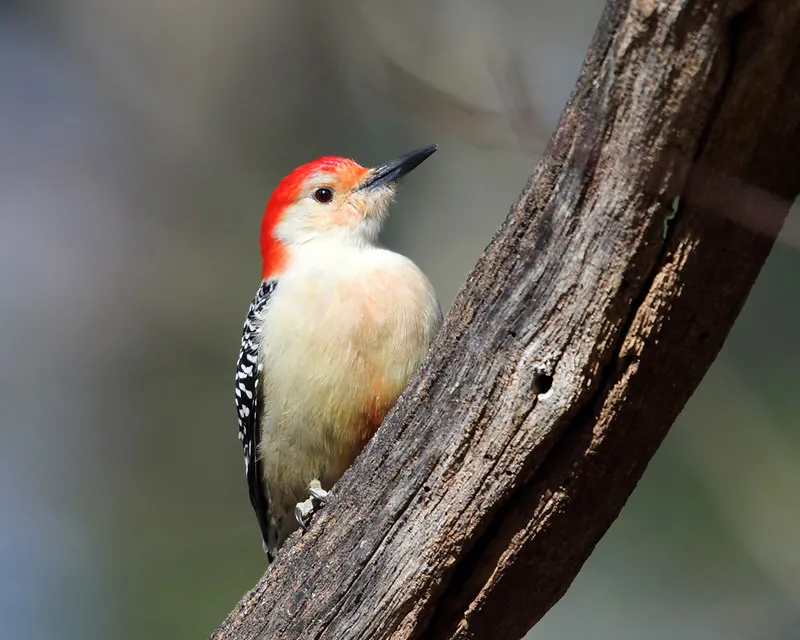
It isn’t only the belly of this woodpecker that is red but also its head. The color of the head is darker than its belly, which is often paler and almost impossible to recognize.
Attracting red-bellied woodpeckers is easy, so you do not have to go far for an up-close encounter. You can lure them into backyard feeders with fruits, insects, and acorns.
The most common places where you can see a red-bellied woodpecker would be in the eastern half of continental North America. They frequent woodlands, suburban parks, and wetlands.
If you want to see a red-bellied woodpecker in the wild, you will find them hitching along trunks and branches of medium to large trees. They will pick and drill bark surfaces.
3. Northern Cardinal
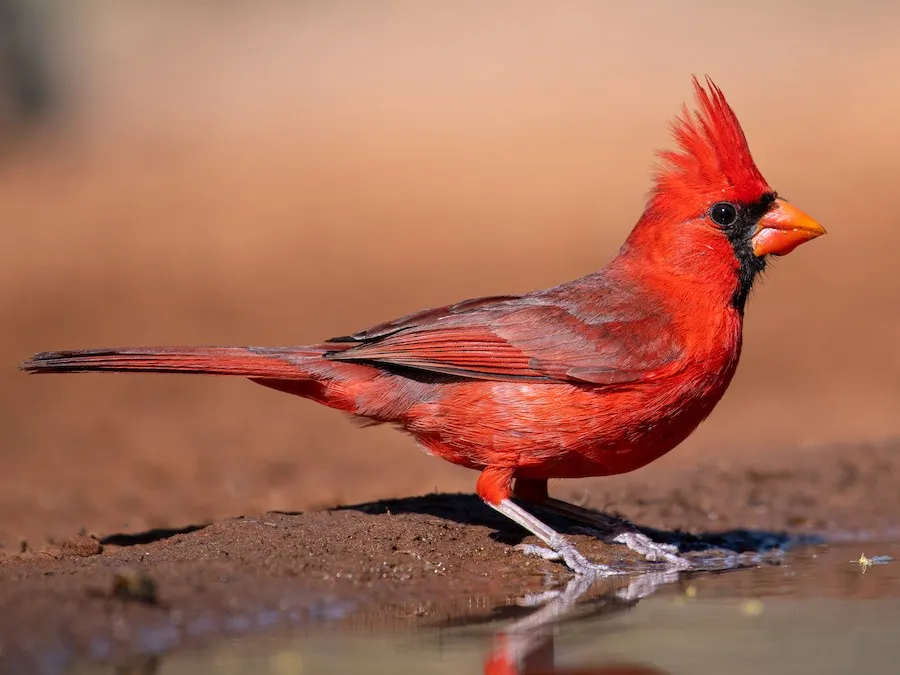
One of the most common birds in North and Central America, the northern cardinal is a passerine. The latter includes almost half of all bird species and is known for the design of the toes that allow them to perch.
The shade of red on its head makes it almost impossible to take your eyes off a northern cardinal when you see one. However, only males are bright, and females are often pale brown in most of its body.
If you are looking for northern cardinals, look for dense shrubs in overgrown fields and forest edges.
Males are known not only for their bright red heads but also for being territorial. They will defend their nesting sites aggressively. They can even fight themselves when they see their reflection in the mirror.
4. House Finch
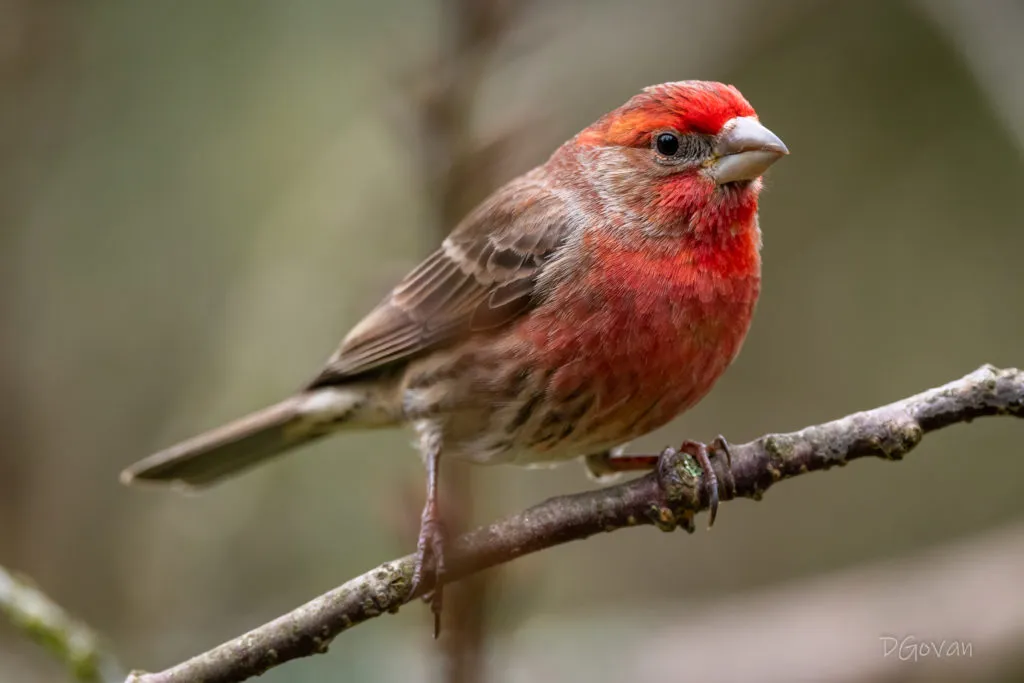
The house finch has a small body with an average length of 5.1 to 5.5 inches. On the other hand, their wings can span a maximum of 9.8 inches.
The color patterns differ depending on gender. Males have rosy-red faces and upper breasts. The tail, belly, and back, meanwhile, have brown streaks. Its red rump is highly evident during its flight. Females, on the other hand, are grayish brown, which makes them quite a challenge to spot.
House finches are present even in locations with human civilization, including buildings and lawns. They are also common in stables and barns. Meanwhile, their natural habitats include open coniferous forests, oak savannahs, and desert grasslands.
5. Scarlet Tanager
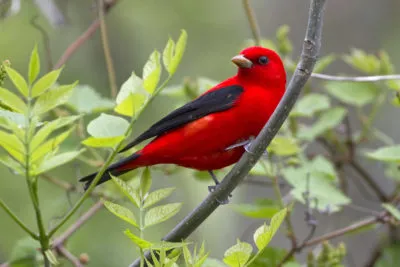
With their red bodies and heads, scarlet tanagers are almost impossible to miss when you see them. They even look more beautiful because of their black wings.
They are common in Eastern North America, specifically in wide wooded areas. Come winter, around October, they will migrate to Canada and South America.
In the summer, the scarlet tanager is insectivorous. Meanwhile, in the winter and during migration, their diet will include fruits.
Many people refer to the scarlet tanager’s song as that of a robin with a sore throat. They are noisy, especially when they are around predators.
6. Red-Breasted Sapsucker
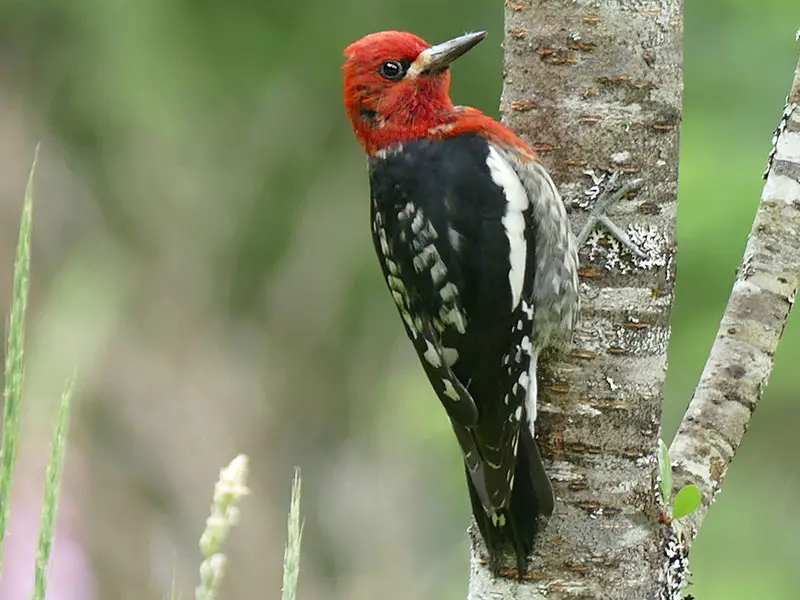
A medium-sized woodpecker, the red-breasted sapsucker has a red breast and head. The back and wings are black and white while the belly is off-white.
Males and females share similar physical characteristics, including the red breast and head, as well as a white spot between the bill and eye. The back, on the other hand, has black and white patterns.
You can see red-breasted sapsuckers hanging on tree trunks. They also frequent crevices where they search for insects in the bark. They will drill shallow holes on tree surfaces and will lick sap coming out.
These birds are a common sight in western North America. They are often in pine forests with deciduous trees, including alder and aspen.
7. Purple Finch
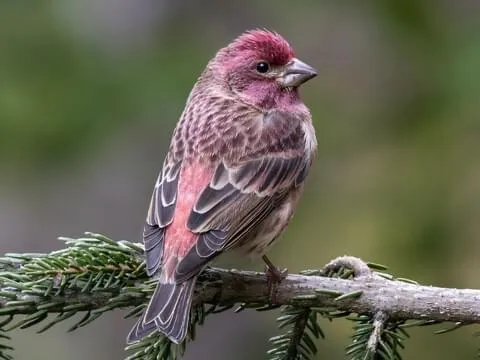
When you first see a purple finch, you might think that it is a house finch. They have the same breast and head color. However, purple finches have more distinct red colorations throughout their bodies.
Like many birds, the diet of a purple finch is varied and will depend on the season. In the winter, they like seeds, including from trees like elm and ash. They will also eat insects like beetles and caterpillars.
No need to go far if you want to see a purple finch in action. They will come to your backyard, especially if you have the right bird feeder. Fill it with foods like black oil sunflower seeds.
8. Downy Woodpecker

A small bird that loves backyard feeders, the downy woodpecker is one of the most common species in North America.
To identify downy woodpeckers, some of the things to look for are their straight and chisel-like bill, straight posture, and wide shoulders. Its bill seems small for its size and compared to the bill of other woodpeckers.
Open woodlands and deciduous forests are some of the most common habitats of downy woodpeckers. They like locations with hickory, maple, oak, hemlock, and beech, among other trees. They can also live in cultivated areas, including orchards.
9. Pine Grosbeak

The pine grosbeak is a large bird with a plump body. Males have a pinkish-red crown, rump, and back. The back is streaked while the tail has white underparts. The wings and tail, meanwhile, are blackish brown.
On the other head, females have an olive-green head instead of red. The back and the underparts are gray while the tail and wings are blackish brown.
As for their habitats, you will see pine grosbeaks in open evergreen forests. Fir, pine, and spruce are some of the trees that they prefer.
You will see these birds in the western United States, British Columbia, and Canada. From the Rocky Mountains to the Sierra Nevada, they live in many places in North America.
10. Pileated Woodpecker
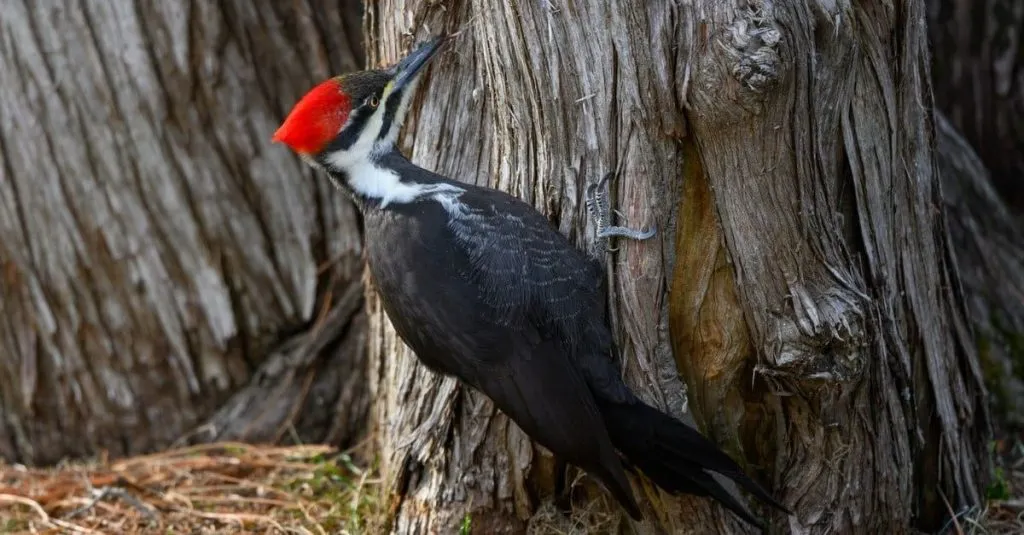
Their red heads are sure to captivate attention. Their bright crest stands out amidst the white body adorned with white stripes. They also have long black tails. To add, their faces are mostly white with a black mask.
You can attract pileated woodpeckers in your backyard by filling a bird feeder with suet. It is also possible to lure them if you have dying or dead trees in the yard.
Carpenter ants make up to 60% of the diet of pileated woodpeckers. Nonetheless, they will also consume nuts, berries, and wild fruits.
Pileated woodpeckers have a strong and pointed bill. With this, they will leave a distinctive rectangular mark on soft bark.
11. Cassin’s Finch
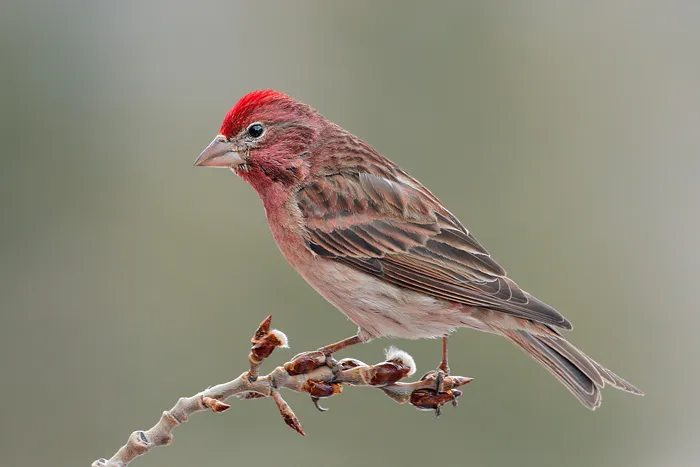
A close relative of the house and purple finches, the Cassin’s finch is a small songbird with a straight-sided, long, and heavy bill.
Male Cassin’s finches are rosy-pink throughout their body with an intense red crown. Females, on the other hand, are mostly brown and white with streaks.
Seeds, berries, and buds are the most common foods consumed by Cassin’s finches. In the summer, they can also eat insects.
You will find these birds in evergreen forests, especially those at an elevation of up to 10,000 feet. However, they will move to lower elevations in the winter.
12. Western Tanager
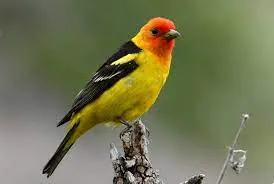
The bright colors of the western tanager make it a head-turner. They are a mix of bloody red and yellow with olive-green tips at the back.
When foraging, it is most common to see the western tanager on top of trees. They will look for insects to eat in dense foliage. Occasionally, they can also catch insects even when they are flying mid-air.
Many of these birds will breed in western Northern America. Meanwhile, in the winter, they will migrate to Costa Rica and Mexico.
13. Andean Cock-Of-The-Rock
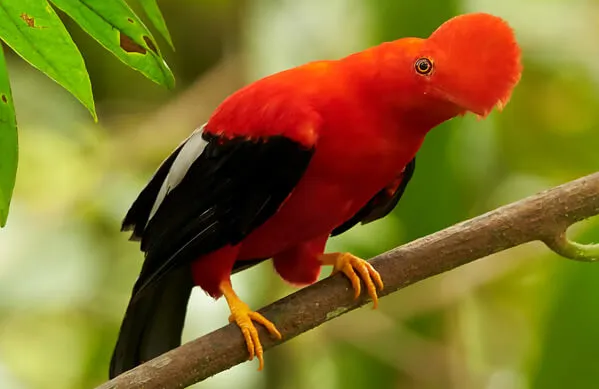
One of the most distinct-looking birds on this list, the Andean Cock-Of-The-Rock has an eye-catching red plumage. The wings are black with white streaks. They are also recognizable because of their fan-like crest that almost hides their bill.
Spotting these birds, however, is a rare treat. If you want to see them up close, your best bet is to go on a bird-watching trip to the cloud forests in the Andes Mountains.
Most of its diet is fruits and insects. Occasionally, they can also feed on small mammals and frogs.
14. Acorn Woodpecker
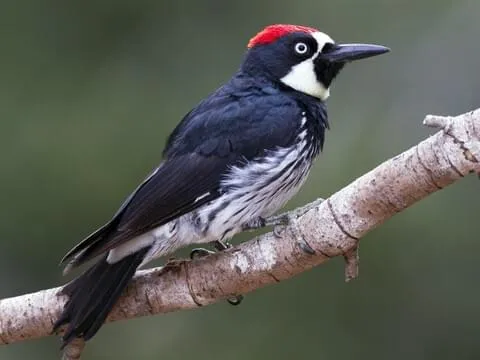
Aside from its red head, the acorn woodpecker is identifiable through its whitish-black underbody, black back, and white face.
In North America, the acorn woodpecker has a limited range. They are most common in the southern states, with some sightings recorded on the California coast as well.
With its name, you will already have an idea of what it eats. The majority of its diet is acorns, although it can also eat ants.
This woodpecker has a string bill, which it uses to dig holes in trees. In turn, this is where they store their food for later consumption.
15. Red-Capped Manakin
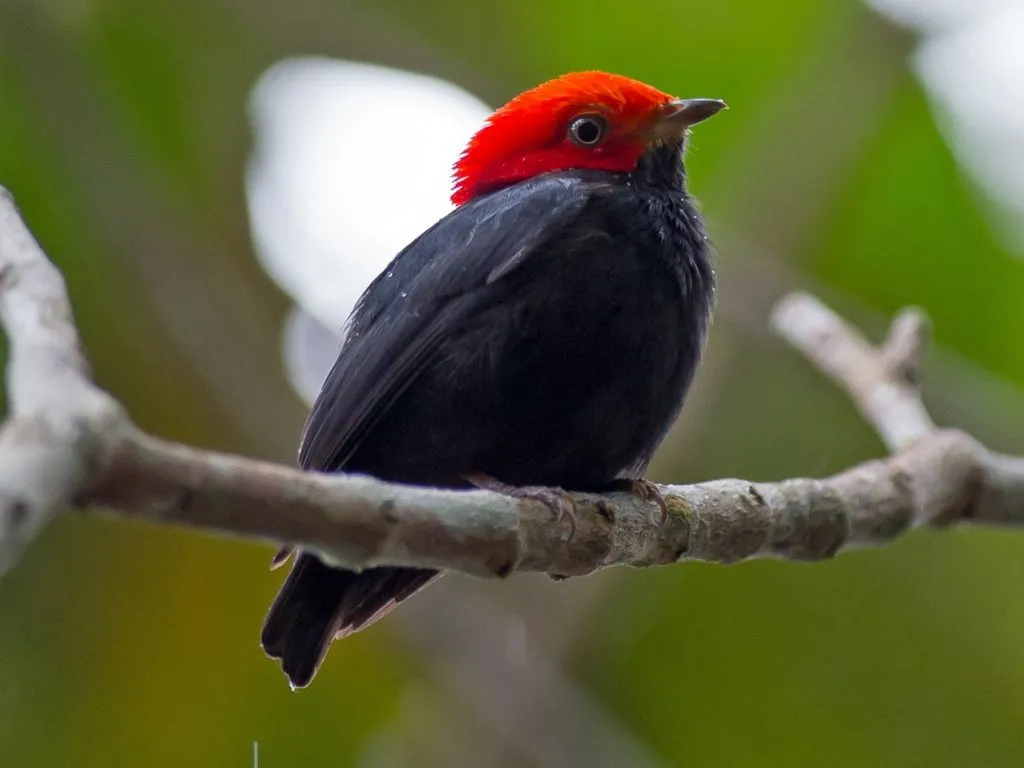
The red-capped manakin is a head-turner. While it is a small passerine bird, it is sure to grab your attention. Males have bright red heads, which are even made more beautiful by their velvety black bodies. On the other hand, females are olive-green on the upper body while their lower body is yellowish-green.
For their diet, red-capped manakins are frugivorous. Their bills allow them to eat fruits by cutting them efficiently. They have small stomachs, so their eaten fruit does not stay in the proventriculus.
16. Red Crossbill
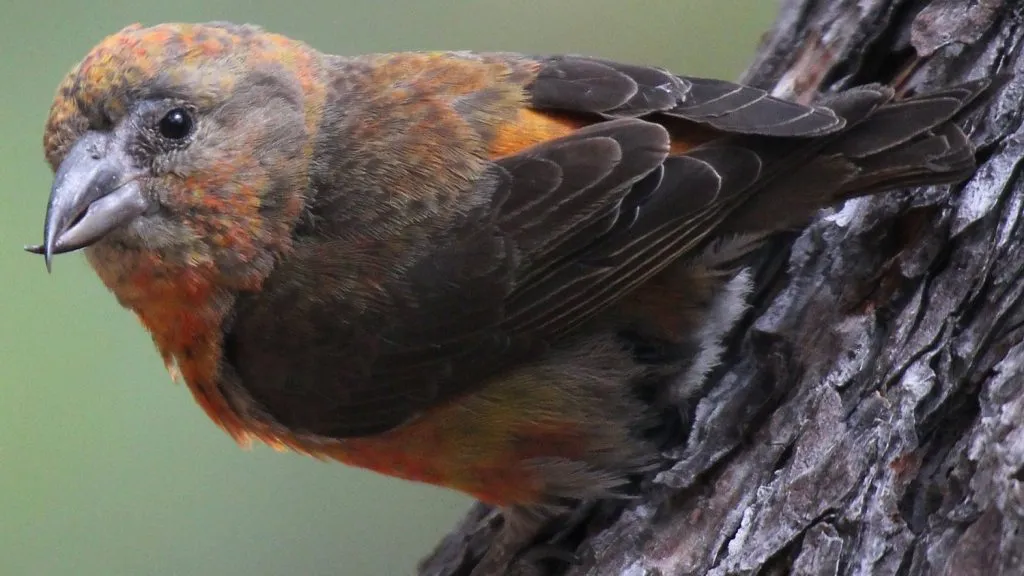
A stocky songbird, male red crossbills are brick red throughout their bodies with the tail and wings having a darker shade. Meanwhile, females are olive-brown, yellowish-brown, or brownish.
You will see these birds foraging in flocks looking for food. They will eat mostly conifer seeds. However, their diet can also include tree buds, berries, and fruits.
Most red crossbills are found in mature and coniferous forests, especially those with pine, hemlock, spruce, and fir.
17. Vermilion Flycatcher
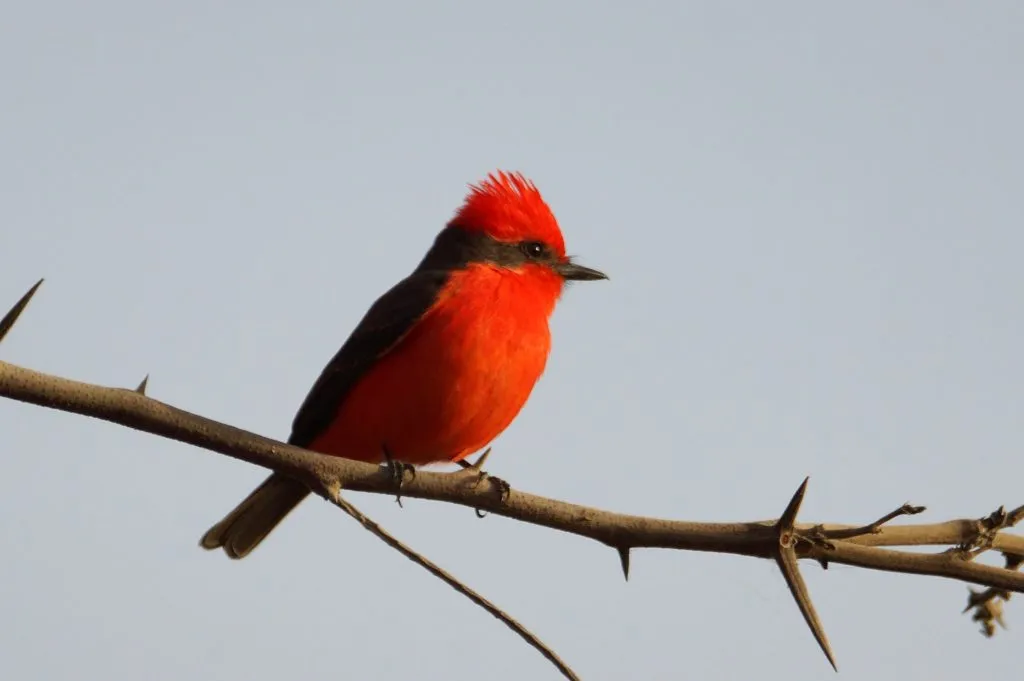
The male vermillion flycatcher is more noticeable compared to their female counterparts. They have a bright red plumage, which is darker on their head than the rest of the body. The rest of its body is blackish-brown.
Southwest American open countries are the most common habitats for vermilion flycatchers. Specifically, you can find them in parks, desserts, farmlands, canyon mouths, and arid scrublands.
In most cases, the vermilion flycatcher will eat flying insects. It will fly on its prey and capture the insect through its wings. On average, they feed at around ten feet from the ground.
18. Summer Tanager
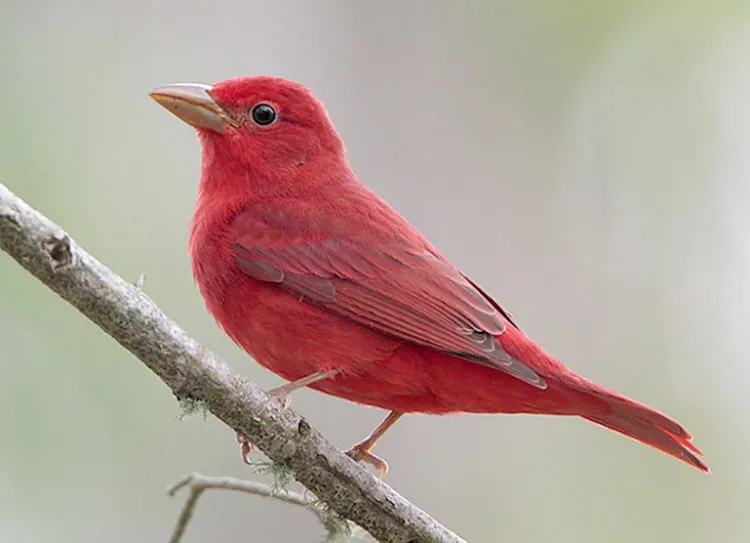
With the bright red head and body of a male summer tanager, it is unmistakable. The female, on the other hand, is yellowish all over with a pinkish bill. Meanwhile, juveniles are greenish-yellow.
Summer tanagers have a wide distribution in North America, with most of them in the southeastern part of the country. In the winter, they will move to the tropics, specifically in Central and South America.
These birds love staying high in forest canopies. They will sit still and catch a flying insect when it sees one. Aside from insects, they can also eat berries.
19. Crimson Sunbird
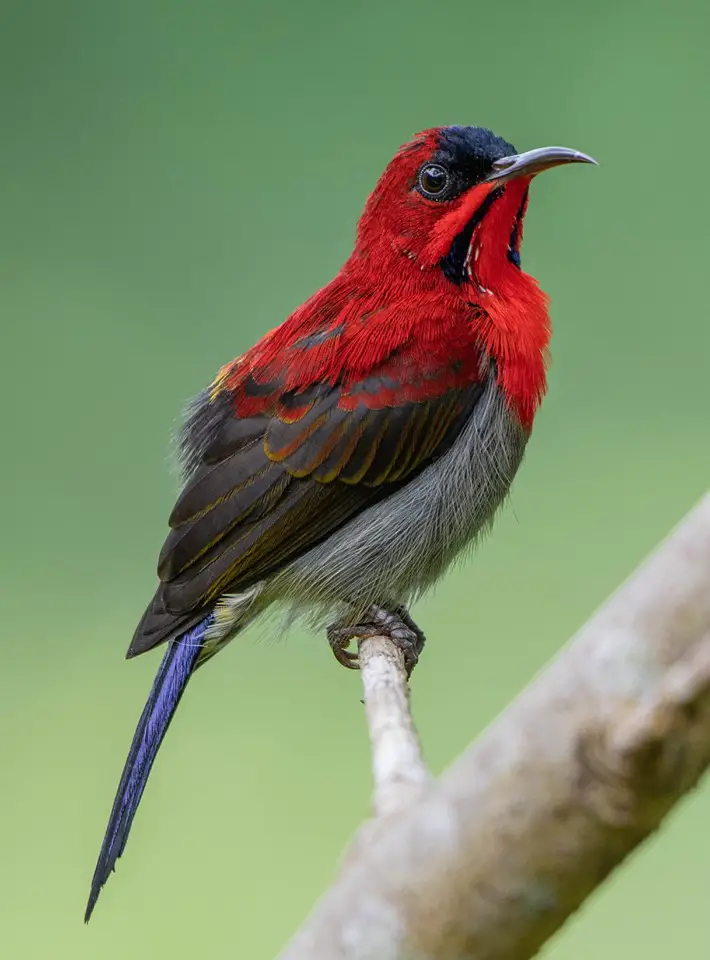
A medium-sized bird, a male crimson sunbird is bright red with a glittering blue cap and dark gray belly. Females, on the other hand, have brighter underparts and are mostly olive-yellow throughout their bodies.
Nectar is the main food source for these birds. Nonetheless, there are also occasions when they will eat insects.
The range of the crimson sunbird is limited, and it is almost impossible to find them in North America. Some of their native habitats are the Philippines and India.
20. Anna’s Hummingbird
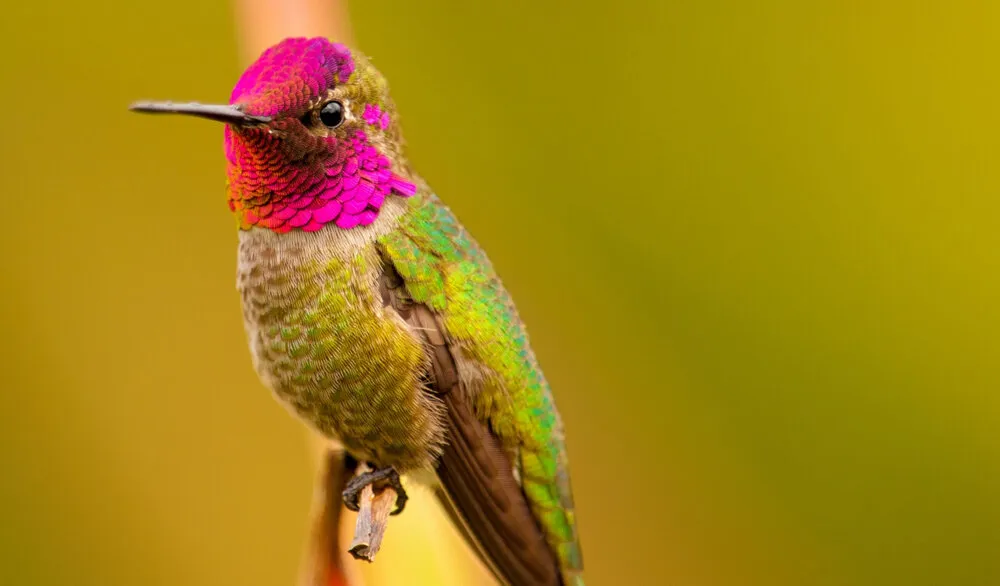
Its head is not as red as the others on this list. It is a bit pinkish. They also have rose-pink throats and emerald-green bodies. Females are not as colorful as males.
Some of the most common places where you can see these birds are residential streets, parks, yards, savannas, riverside woods, and eucalyptus groves. They are also frequent visitors of bird feeders.
The breeding season of Anna’s hummingbirds starts in mid-December and can last until early June. Males will arrive early to build their territory and gather food. Females will arrive after a few weeks.
More so, their breeding season is also marked by the display of bold flight patterns. Males can dive vertically.
Watch This!
Frequently Asked Questions
What is a black and white bird with a red head?
If you see a black and white flying creature with a red head, chances are, it is a red-headed woodpecker. Although, some species can have blue in its feather. You will find them in wooded regions, open countries, and forests with dying trees.
What finches have red heads?
Some of the most common types of finches with a red head are house finches, purple finches, and Cassin’s finches.
Conclusion
From dense forests to private backyards, a red-headed bird stands out. Identifying the species, however, can be challenging. With the discussions above, we hope that it is easier for you to recognize flying creatures with fiery caps next time you see one.
Are there birds with red heads that you would like to add to this list? Leave a comment below and tell us what we missed.

